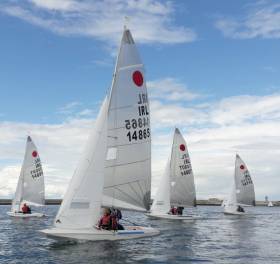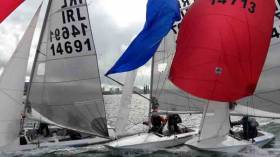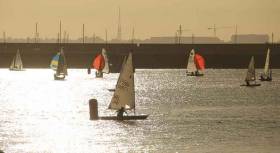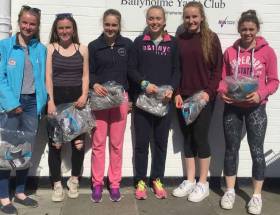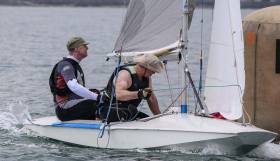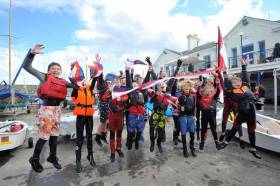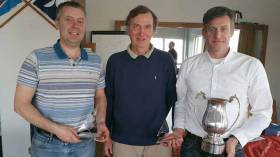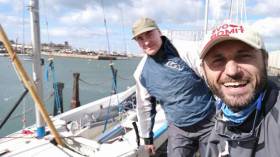Displaying items by tag: Fireball
Five Fireballs Go DBSC Sailing!
It didn’t really look like Fireball racing would be possible yesterday evening! Having enjoyed another sunny day in Dun Laoghaire, though it was not as “blue sky” as the previous three days, the expectation of a reasonable sea breeze was not met! Instead the seascape was a very flat Dublin Bay and an even flatter harbour seascape. Consequently we launched in hope rather than expectation and the trip from the Royal St George to the start area at the West Pier was as slow as the weather suggested it would be. The race management team initially postponed the start and then set a mark that was in line with the end of the East Pier, about 60m inside the harbour mouth. Course X1 was indicated giving us two roundings of the weather mark and a downwind finish.
In the PY start, Pierre Long in his IDRA started on the pin, on port and gained a huge early advantage over the rest of his fleet – he went on to win, as well. This was the prompt for the five Fireballs to gather at the pin, each attempting to do something similar. Though neither was on the pin, Noel Butler and Stephen Oram (15061) and Teddy Byrne & Conor Clancy (14807) started on port, while Cariosa Power & Marie Barry (14854) and Frank Miller & Ed Butler (14713) started on starboard and went left initially. Louise McKenna & Cormac Bradley (14691) started on starboard, tacked immediately onto port and found themselves chasing the other four.
The “better” wind was on the outside of the course and Power and Miller benefitted from being on that side. Byrne & Clancy, with Byrne helming, were sailing in close company with Butler & Oram. Subject to correction, my recall of the order of rounding was Power, Miller, Byrne, Butler and McKenna. For the downwind leg, the standard route seemed to be to sail straight on starboard after the spreader mark and then put in a gybe to get to the leeward mark. Of course, the challenge was when to gybe.
On the second upwind leg, the fleet worked the left hand side to varying degrees and Miller found himself in second place rounding the top weather mark. Staying high on the next downwind leg Miller was able to sail around the fleet and take a well-deserved win. Behind him the order was Butler, Byrne, Power and McKenna.
For the second race the weather mark was moved a significant distance to the right and again course X1 was signalled. Again, the pin end was favoured but the jockeying to get to it was a little less intense, with intense being an exaggeration given the wind strength. Four of the boats were on one side of the course, while McKenna ploughed a solitary furrow on the right hand side. For the early stages of the beat, this looked as though it might pay, but as she put in a starboard hitch to get to the weather mark, three of the four “lefties” went ahead of her. Butler led, followed by Byrne and Miller. The fleet stayed on the right hand-side of the run, leaving the gybe to the leeward mark late.
At the next weather mark Miller and Clancy found themselves in the reverse situation to last Tuesday night. Miller was the starboard tacked boat, Clancy was in the port tacked boat trying to get round the mark.........and this time by way of my proximity to the two boats.........turns were required which Byrne duly did! In the wind conditions, this might have signalled “game over”, but forced into a different downwind strategy by way of the penalty turns, Byrne & Clancy went over the line first. Miller meanwhile had got ahead of Butler but to my mind was in a position where Butler controlled his destiny – Miller couldn’t gybe across until Butler went! The gybes were triggered with Butler going first, but Miller managed to wriggle his way over the line before him by the tightest of margins.
|
DBSC Tuesday Nights: Series 2 (4 sailed, 1 discard) |
R1 |
R2 |
R3 |
R4 |
Tot. |
|||||||
|
Conor Clancy/Teddy Byrne & James Clancy |
14807 |
RStGYC |
1 |
2 |
3 |
1 |
4 |
|||||
|
Frank Miller & Ed Butler |
14713 |
DMYC |
2 |
3 |
1 |
2 |
5 |
|||||
|
Cariosa Power & Marie Barry |
14854 |
NYC |
3 |
1 |
4 |
5 |
8 |
|||||
|
Louise McKenna & Cormac Bradley |
14691 |
RStGYC |
4 |
4 |
5 |
4 |
12 |
|||||
|
Noel Butler & Stephen Oram |
15061 |
NYC |
8 |
8 |
2 |
3 |
13 |
|||||
The regatta scene returns for the Fireballs with an event at Greystones this weekend. In a departure from our normal format, this year’s Open Championship will be sailed as a one-day event, Saturday, with Greystones also being a debutant venue for the Fireballs. Frank Miller has been “banging the drums” to generate numbers for this weekend and it looks as though we will have a bigger number than we had in Ballyholme. Frank and Ed Butler have put the latter 14990 back into commission to sail this weekend and I believe our “Fireballers in Flying Fifteens”, Margaret Casey & Neil Colin will also be in Greystones. The class is also reminded that we are entering the Volvo Dun Laoghaire Regatta as a class, but we will only get a separate start if we have sufficient numbers.
Balmy Tuesday Evening Proves a Fireball Sailing Delight
While Tuesday was a warm blustery day by the time Fireballers descended on the waterfront clubs the breeze was fading. Early birds Frank Miller and Ed Butler sailed to the harbour mouth to be greeted by 180 degree shifts and finally zero air.
The DBSC committee boat and ribs made a brief foray outside but faced with almost no wind and a strong incoming tide signalled the gathering sailors to remain in the harbour. Miraculously a reasonable breeze returned from the same SW direction as earlier and a W-L course was set up with the X1 board signalling (in the unique language of DBSC Sis) two windward-leeward rounds with a downwind finish. So it was that five Fireballs took off in the second start following the slow PY fleet, with Miller/Butler favouring a pin end start and the rest distributed along the line.
The pair went further left than the rest and picked up a slightly better breeze and after a shift managed to edge ahead of the Clancy Brothers and Noel Butler/Stephen Oram. They held that lead over the course though as they approached the finish noticed that Butler/Oram had carved a sharper angled approach towards the committee boat end and the leeward mark. The pair crossed to line to silence and saw to their horror that Butler/Oram had rounded the leeward and were cheerfully chewing their way back up the beat for another round. Only Miller/Butler and the Clancy’s gave chase but the game was over and the just rewards went to those who took a closer look at the number of rounds to be sailed in the 3 minutes before their start was signalled.
Race two took place in similar conditions, this time Butler/Oram stamped their authority on the race early and although the Clancy’s and Miller/Butler stayed close the pair won race two, with Louise McKenna/Hermine O’Keeffe in 4rd and Cariosa Power/Marie Barry in 5th. Despite some frustrations this was a very pleasant evening’s racing in warm pleasant conditions.
Ger Owens Fireball Training Weekend at Dun Laoghaire
When Ger Owens’ 'Loopies' replace Adam Bower’s 'Woompatah' you know it must be Fireball Training Weekend writes Neil Cramer.
With generous sponsorship from the ISA Class Training Scheme and hosting by the DMYC, the Fireball Class assembled in Dun Laoghaire on Saturday for the first day of its annual training camp under the coaching of Ger Owens, the renowned 470 Olympic and GP14 sailor.
Under bright, clear skies with only the odd passing shower to dampen the mood, the weather was perfect for a full-on day of training. The group of 12 sailors started the day in classroom mode where Owens managed to condense the entire world of race-winning strategy into five concise pointers designed to instill a belief in one’s ability to hit the front of the fleet without wondering how one got there and how long one could hang on before being passed out by ‘better’ sailors!
Once, these topics had been unravelled, the fleet took to the water to undergo Ger’s infamous ‘Loopies’, created to induce ‘muscle memory’ for all points of sailing. Maybe, Ger thought the fleet was suffering from mild dementia because they were certainly dizzy and sweaty when they came out of ‘loopie’ mode and moved on to point-to-point circuit sprints.
Following a brief lunch ashore combined with detailed de-briefing, the fleet proceeded to the end of the harbour where a testing sequence of ultra-short races had everyone’s stress levels reach limits not seen in even the most difficult of event conditions. What is it about the sound of a whistle or hoot that gets Fireball crews all wound-up & ready to take no prisoners? Extremely short races, with no respite in between gave the participants a thorough workout & tested that ‘muscle memory’ to the limit.
As a result of the session the participants now understand why:
* the Kicker could sometimes become a liability,
* why the most important piece of equipment on the boat is a €10 piece flimsy material &
* why what goes on under the boom is a vital source of information.
* The way up is not necessarily the way back down
Want to know these secrets too? Why not acquire a Fireball and join the fray ? For as little as little £2k you can be the new owner for an “all white” Winder foam sandwich boat or as little as £800 for a restored timber boat. Then come along to our 2nd Fireball Training date later on this summer & learn why you too belong at the top of the fleet looking back...
DBSC Fireballs Have Genteel Evening at Dun Laoghaire
Four Fireballs came under the starter’s orders for the third Tuesday night of the DBSC Summer Series. Given the warm conditions during the day and the strong tide outside, the decision was made to keep the dinghy fleets inside – presumably on the basis that the sea breeze would fade as the evening wore on, leaving the fleets exposed to a flooding tide. While it may not have made immediate sense on sailing out to the start area, it was the right thing to do.
The four boats were in a close bunch at the pin end of the line when the start signal went and three of the boats stayed on a starboard tack to the extreme left of the course, adjacent to the harbour mouth. Messrs Butler(N) and Clancy (C) with regular crews Oram (S) and Clancy (J) respectively gave all the indications that they were going to stick close to each other and while Butler had the upper hand initially, Clancy took it off him and was never headed thereafter. The ladies, in the form of Cariosa Power and Marie Barry, also went left but having fallen behind the other three off the start, the fourth boat, which went up the middle of the course, Miller (F) and Bradley (C) had hopes that they might slot into 3rd. No such luck and continuing their form of the weekend, this pair found themselves in splendid isolation, ploughing a furrow up the middle. It didn’t get any better for them as the race progressed! During the race the girls closed on Butler & Oram, to within a boat-length at the second windward mark, but on the downwind leg to the finish Butler & Oram sailed away to take a comfortable second to the Clancys.
The Race Officer moved the weather mark to port (northwards) before re-instating it in its original position to get the second race of the evening away. Again the four boats bunched together off the start and this time Miller and Bradley stayed with them. It paid dividends because they rounded the first weather mark in third and that sense of security was enhanced when the recently crowned Ulster Champions, Butler & Oram took a penalty turn on the water, presumably for a mark infringement.
The girls were enjoying the easing wind as they sailed into second but the Clancys were not threatened at all. Up the second and last beat, Clancy took a hitch left to ensure he stayed to weather of the chasing boats. Miller and Power sailed up the middle of the beat and while Power appeared to be going marginally faster, she was also slipping to leeward as well. Butler went left but was initially unable to close the gap. Miller rounded second but his discomfort level was doubled as Power went one way and Butler the other on the downwind leg to the finish. Butler closed initially and then gybed to go into the middle of the course while Miller and Power stayed out towards the harbour mouth. Miller gybed late for the finish and despite being on a converging course with Butler was able to comfortably cross him as Miller finished second at the committee boat end. Power, too, finished ahead of Butler.
|
DBSC Tuesday Nights: Series 1 – 9th May 2017. |
R1 |
R2 |
Nett |
|||
|
1 |
Conor & James Clancy |
14807 |
RStGYC |
1 |
1 |
2 |
|
2 |
Frank Miller & Cormac Bradley |
14713 |
DMYC |
4 |
2 |
6 |
|
3 |
Cariosa Power & Marie Barry |
14854 |
NYC |
3 |
3 |
6 |
|
4 |
Noel Butler & Stephen Oram |
15061 |
NYC |
2 |
4 |
6 |
Malahide Girls Top 420 Ulster Championships
Nearly 30 sailors attended the joint 420 and Fireball Ulster Championships last weekend with a mixture of conditions to test out the sailors writes Mark Mackey. Most of the visitors travelled up from Cork and Dublin to compete in the two different classes – both are double handed dinghies with a single trapeze wire for the crew, but there the similarities end.
The 420 is a rounded more plastic style mini version of the 470 class which is sailed at the Olympic Games by both male and female crews. The 420 is used as a youth pathway class and many of the teenage sailors had already visited Ballyholme over Easter at the ISA Youth Championhips. All-girl crews dominated the event despite the strong winds on Saturday, occupying the first 3 places overall. It was great to see local sailor Adam Lockart getting a run out having struggled to find a regular crew – Daniel Thompson from Wexford Harbour helped out this weekend.
The Fireball is a much sleeker craft orginially built in wood – in fact many were built in the Ballyholme chnaging rooms over the winters back in the 1970's. These days they are glass-fibre with lots of controls and tweaks to be made whilst racing. As opposed to the teenage crews of the 420's, the Fireball attract the older generation with many of the sailors well into their 60's and some their 80's – a marvellous example of the length of time that people can continue to compete and enjoy sailing. These are not sedentiary boats however with big mainsails that power them up to speeds that are only surpassed by the Olympic skiffs and multihull dinghy classes. See Fireball class report here.
After Saturday's breeze and lumpy seas, the sunshine came out for Sundays races with a light 5-8 knot breeze and flat water. A range of conditions is always useful to test out the best sailors who still manage to excel no matter what they are faced with. Malahide's Gemma McDowell and Emma Gallagher followed their second place 2 weeks ago with top of the podium in the 420 class, while Noel Butler and Stephen Oram are no strangers to the top of the Fireball fleet either. Both classes gave their thanks to the club, sponsor P&O Ferries and Race Officer Robin Gray.
420 Ulsters:
1st Gemma McDowell and Emma Gallagher, Malahide YC
2nd Grace O'Beirne and Kathy Kelly, Royal St George YC
3rd Nicola and Fiona Ferguson National YC
A small group of Fireballs, combined with a slightly larger group of 420s enjoyed a light weather start to the regatta season under the burgee of Ballyholme Yacht Club, on Belfast Lough’s southern shore for the Ulster Championships this past weekend. Ballyholme has always been a popular destination for the Fireballs with a combination of an excellent Race Officer in Robin Gray and traditional northern hospitality the mainstays of that attraction. While our smaller numbers changed the requirement for on-site hospitality, Robin Gray was as excellent as ever, getting six races in in challenging circumstances, particularly on the Saturday. Sunday was easier in terms of the wind direction but for the competitors, the challenge of going the right way and avoiding the wind lulls on the course was just as demanding.
Noel Butler and Stephen Oram (National Yacht Club, 15061) dominated the winners’ enclosure by taking five race wins. In the sixth race they swapped roles on the boat, with Stephen taking over as helm. That led to an opening of the door to another winner, Niall McGrotty and Neil Cramer (Skerries Sailing Club, 14938) which was enough to secure second overall ahead of Michael Ennis & Marie Barry (National Yacht Club, 14854). However, while Butler & Oram won all the races, they didn’t have things completely their own way even in those races. In the first race of the Saturday, Frank Miller & Cormac Bradley (Dun Laoghaire Motor Yacht Club, 14713) led around the first weather mark and Michael & Marie pushed them all the way in the fifth race before a tight cover had to be applied on the last leg of the course from Mark 4 of the trapezoid to the finish to make sure Michael & Marie didn’t sneak out from underneath them. Niall & Neil also pushed the eventual winners and the “pink ladies”, Louise McKenna and Hermine O’Keeffe (Royal St George Yacht Club, 14691) while not quite pushing the overall winners were also close enough to benefit from any mistakes the leaders made. Saturday started overcast and cool but cleared and warmed as the day progressed, to the extent that we came ashore after three races to blue skies and glorious sunshine. Saturday’s wind was better than Sunday with some trapezing being possible. The consequence was that the racing was reasonably tightly bunched. Dinner was eaten al fresco at a nearby by pub/restaurant. Our weather was made all the more intriguing by hearing that DBSC’s racing in Dun Laoghaire had been cancelled due to strong wind.
On Sunday we woke to clear blue skies and a much more fickle breeze but Race Officer Robin Gray made an early declaration of his intent by not appearing at the club but rather, going afloat on the committee boat directly from Bangor marina. While some of the other light crews may have had some trapezing on Sunday, this correspondent only hooked up very rarely during the day’s proceedings. As the biggest combination on the water, Miller & Bradley were off the pace in the lighter first two races and it was only in the last race when there was a bit more wind that they were able to stay with their opposition. Trapezoid courses were the order of the weekend in order to accommodate the two fleets and the preference of the 420s for this course configuration.
|
Fireball Ulsters – Ballyholme Yacht Club (with 420s) |
R1 |
R2 |
R3 |
R4 |
R5 |
R6 |
Nett |
|||
|
1 |
Noel Butler & Stephen Oram |
NYC |
15061 |
1 |
1 |
1 |
1 |
1 |
5 |
5 |
|
2 |
Niall McGrotty & Neil Cramer |
SSC |
14938 |
2 |
5 |
2 |
3 |
3 |
1 |
11 |
|
3 |
Michael Ennis & Marie Barry |
NYC |
14854 |
4 |
3 |
4 |
2 |
2 |
3 |
14 |
National Yacht Club Junior Sailors Celebrate Links to Olympic Silver Medal & America’s Cup
A very special Golden Jubilee coming up in May provides links to an Irish Olympic Sailing Silver Medal, the Fireball World Championship, and the America’s Cup. W M Nixon finds the widest connections go even further than that to include a pioneering world voyage.
It was in May 1967 that the irrepressible Carmel Winkelmann oversaw the first results of a junior sailing initiative at the National Yacht Cub, her home club in Dun Laoghaire. It became a movement which went on which to have nationwide and worldwide ramifications, so much so that within Ireland we’re looking at an unbroken line in Irish sailing which is continued through the club which currently holds the title of ISA Training Centre of the Year, which for 2017 is Foynes Yacht Club on the Shannon Estuary.
That a successful club at the heart of the Atlantic seaboard can trace an almost magic thread back to something which happened at a club on Dublin Bay a long time ago is quite a story in itself. Particularly when the Atlantic seaboard club itself is imbued, as Foynes is, with the spirit of legendary circumnavigator Conor O’Brien. However, when the story is shaping up to continue with the Golden Jubilee as the latest chapter, it gives us an opportunity both to celebrate, and take stock of what it has all meant.
 Foynes Yacht Club, heirs to an Irish tradition of junior sail training which was first formalized by the National Yacht Club 50 years ago. At the Irish Sailing Awards ceremony when Foynes were announced as winners of the ISA Training Centre of the Year Award were (left to right) Simon McGibney (Foynes Senior Instructor), Sailor of the year and Olympic Silver Medallist Annalise Murphy of the National Yacht Club, Elaine O’Mahoney (Foynes Sailing Academy Manager), Pat Finucane (Sailing Academy Principal) and Conor Dillon (Instructor). In a club which is imbued with the spirit of world-girdling Foynes sailor Conor O’Brien, it’s particularly appropriate that Conor Dillon’s sailing CV includes winning the Two-Handed division in the Round Ireland Race, sailing with his father Derek Dillon on a 34-footer. Photo: Inpho
Foynes Yacht Club, heirs to an Irish tradition of junior sail training which was first formalized by the National Yacht Club 50 years ago. At the Irish Sailing Awards ceremony when Foynes were announced as winners of the ISA Training Centre of the Year Award were (left to right) Simon McGibney (Foynes Senior Instructor), Sailor of the year and Olympic Silver Medallist Annalise Murphy of the National Yacht Club, Elaine O’Mahoney (Foynes Sailing Academy Manager), Pat Finucane (Sailing Academy Principal) and Conor Dillon (Instructor). In a club which is imbued with the spirit of world-girdling Foynes sailor Conor O’Brien, it’s particularly appropriate that Conor Dillon’s sailing CV includes winning the Two-Handed division in the Round Ireland Race, sailing with his father Derek Dillon on a 34-footer. Photo: Inpho
But business first. Anyone who has ever taken part in the Junior Training Programme at the National Yacht Club is hereby alerted – if you don’t know already – that on the evening and night of Saturday May 20th, there will be a very special celebration at the clubhouse. The organisers Carmel Winkelmann and Ann Kirwan are particularly keen to trace those who have moved away, but would find much nostalgic pleasure with the meeting of old friends by returning on this day of days. So if that applies to you, or you know anyone to whom it does, please make contact with the key club administrator whom everyone refers to as “Oonagh at the National”, the proper line of contact being [email protected], tel 01-280 5725.
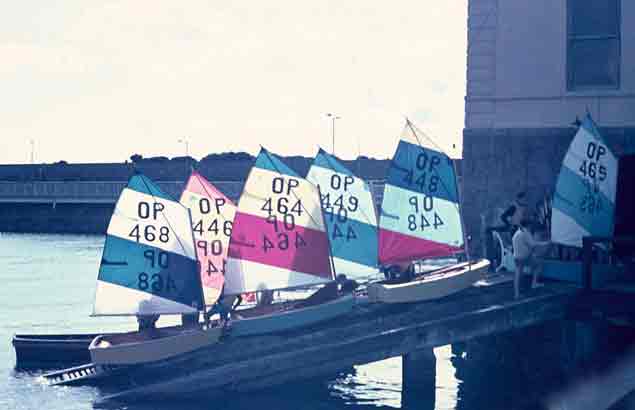 Bright morning of Optimism. The National Yacht Club slipway in 1967, long before the days of an extensive front-of-club platform, with the new dinghies of the Optimist Class being launched out of the cramped boathouse under the club, and down a steep and often very crowded slipway
Bright morning of Optimism. The National Yacht Club slipway in 1967, long before the days of an extensive front-of-club platform, with the new dinghies of the Optimist Class being launched out of the cramped boathouse under the club, and down a steep and often very crowded slipway
To grasp the significance of what is being celebrated, please try to visualize the National Yacht Club as it was fifty years ago. The building itself, standing directly in the harbour, has the air of a fishing lodge in the West of Ireland on its seaward side, and a hint of neo-classicism when seen from the town. But in the early 1960s it was very limited in its shoreside facilites for sailing dinghies. There was a boathouse entered through fine granite arches under the clubhouse itself, but to use it, masts needed to be lowered. It was served by a very steep and easily-crowded slip, while there was access to another slip on the east side of the cub which served a small area where dinghies could be stored. But while there was space for the established classes of Fireflies and some IDRA 14s, some room was also needed for the small tenders for larger yachts moored in the harbour, while the racing keelboats were served by club launches which might be substantial dinghies driven by vintage Seagull outboards.
The concept of a proper dinghy park was still only in its infancy, relatively speaking, for craft such as Dun Laoghaire’s Firefly and IDRA fleets which had been active since the late 1940s. Thus if anyone had a centreboard boat which could reasonably be expected to lie to moorings, she was obliged to do so, and the fleet of small craft lying off the club included the 17ft Mermaids and the 14ft Water Wags.
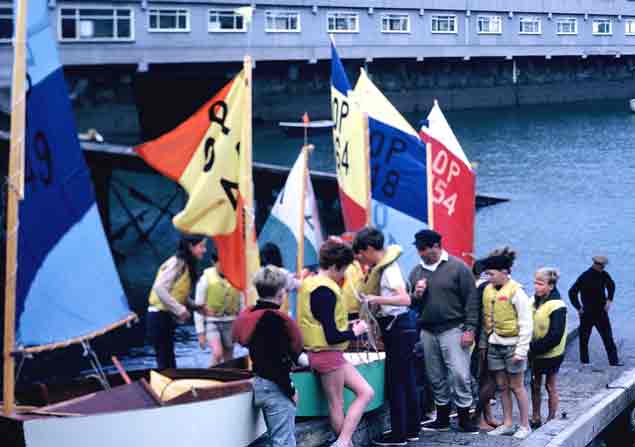 It could get very crowded on that steep slipway. Paddy Kirwan at the centre of a group making do with limited facilities
It could get very crowded on that steep slipway. Paddy Kirwan at the centre of a group making do with limited facilities
To compound the space problems afloat and ashore, during the 1960s the area in the southeast part of Dun Laoghaire Harbour off the National Yacht Club was the focal point for the cross-channel ferry berths. The railway-system serving Mailboat with its emphasis on foot passengers continued to use the Carlisle Pier to the west of the club, but the East Pier was known for a period as the Car Ferry Pier as a busy new roll-on roll-off terminal, which admittedly always had a temporary look about it, had been constructed there to accommodate the new trend in cross-channel travel.
Thus not only was anyone sailing a dinghy from shore at the National YC dong so out of decidedly limited facilities, but they immediately sailed into an area cluttered with a collection of moored boats of all shapes and sizes, and that in turn was set in an area which might have ferry ships berthed close by, or manoeuvring on either side.
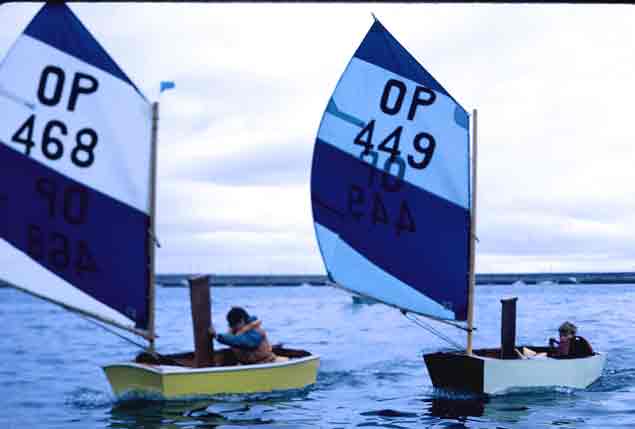 Learning curve. Gina Duffy and John Lavery on a close run in 1967. The latter has won many major championships, including the Fireball Worlds in 1995
Learning curve. Gina Duffy and John Lavery on a close run in 1967. The latter has won many major championships, including the Fireball Worlds in 1995
The comparisons with today’s National Yacht Club with its spacious platform facing out over a much clearer harbour area, and beside it an installation of convenient berthing pontoons, could not be greater. But back in the 1960s, an equally important change was happening – there was a complete re-appraisal of what the most junior sailors really needed in boats and instruction to get the best from the sport.
For sure there were the Fireflies, but in terms of lower age limit they were really aimed at adolescents on the cusp of rapidly growing youth. The other available classes were even more adult-oriented. In fact, the underlying problem was that children going sailing were treated as miniature adults who would somehow pick up the skills of the game through a sort of osmosis, whereas for a crucial period of their lives they would have most benefitted from being treated as a different species, with different boats to meet their needs.
Yet even here, adult views dominated. The grown-ups thought that young people’s boats should at least look like small yachts. Thus a dinghy which was promoted for children by several clubs was the 11ft Yachting World Cartop Heron, which had originally been conceived as a DIY-build which could fit on the roof-rack of the average family car, and was designed with a gunter rig such that all its spars could be stowed within the boat.
It had some good ideas, and with a pretty sheer it fulfilled the adult expectation of what a miniature yacht should look like. But it was surprisingly heavy for its avowed rooftop requirement – you’d have needed a weight-trained family to get it on the car roof. And anyway, it was too large for really small kids who genuinely had the sailing bug.
 The southeast corner of Dun Laoghaire Harbour was very different in 1967, with the East Pier re-designated as the Car Ferry Pier. Yet despite the limitations, the Optimist class quickly caught on after its introduction in 1967
The southeast corner of Dun Laoghaire Harbour was very different in 1967, with the East Pier re-designated as the Car Ferry Pier. Yet despite the limitations, the Optimist class quickly caught on after its introduction in 1967
So a revolutionary approach was needed, and it came thanks to one of the National YC’s international sailing stars, Johnny Hooper. He had achieved Ireland’s first Olympic Race win with Peter Gray in the Flying Dutchman in the 1960 Rome Olympics when the sailing was at Naples. But as an FD campaign towards the 1984 Olympics was prohibitively expensive with the venue in Japan, he returned to his first love of International 505 Racing, and it was at a big 505 championship in Scandinavia in 1965 or thereabouts that he first became aware of the game-changing possibilities of the Optimist for junior sailing.
Scandinavia being rightly renowned for the elegance of its yacht, it speaks volume for the versatility of the Florida-originating Optimist, the “simple little boxboat that sails surprisingly well”, that Scandinavia should lead the movement towards a world body for a boat which, whatever the traditionalists might think, the kids were clearly loving. Founded 1965, the International Optimist Dinghy Association (IODA) had Viggo Jacobsen of Denmark as its first President with his wife Edith as Secretary, and in that same year Johnny Hooper set about introducing the idea of the Optimist to Ireland.
Now if some ordinary Joe had happened to by impressed by an Optimist at some foreign location, and had even brought one home to persuade his fellow sailors that they were looking at the future, the idea probably would have fallen very flat indeed.
But that’s not the Hooper way. Instead, from his highly respected position he quietly targeted fellow National Yacht Club members who were themselves active sailors, but also had children who would benefit from the Optimist experience, and in time a group emerged which was to include initially Johnny Hooper with his wife Bernie giving the longterm involvement, Peter Gray, Paddy & Barbara Kirwan , Don Douglas, Franz & Carmel Winkelmann, Michael McGrath, Arthur Lavery and several others, many of whom had reasonable DIY skills and could see the possibility of building an Optimist in the basement of their Dun Laoghaire homes without too much disruption of the household. By the Autumn of 1966, the project was under way.
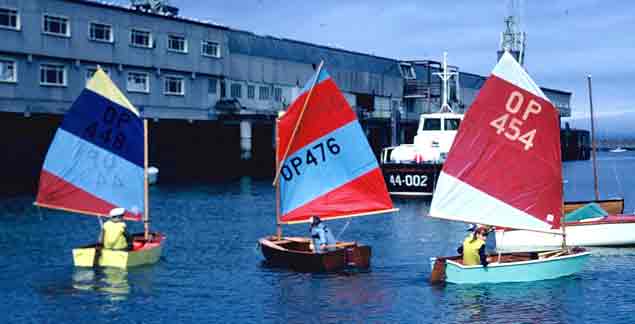 The first of the new fleet sails. Paddy Boyd (left) Ann Kirwan (centre) and Vivienne Lavery right) getting to know their boats
The first of the new fleet sails. Paddy Boyd (left) Ann Kirwan (centre) and Vivienne Lavery right) getting to know their boats
While Johnny Hooper had introduced the idea, he stood back from its continuing implementation, for the Hooper modus operandi was to give an idea enough strength to soon have wings of its own. That certainly happened in the National Yacht Club, for very quickly a manageably small committee was in being, and the formidable Carmel Winkelmann became its secretary. The NYC Junior Programme became her baby, and it always has since been seen as such, even though the number of people involved in administering the programme over the fifty years, as the NYC facilities have expanded and developed to meet the needs of a modern membership, will now run into the hundreds.
In fact, properly organized junior sailing with boats specifically designed for young people’s needs is now so central to Irish sailing that it takes a huge leap of the imagination to visualize the scene as the first small group of National Yacht Club Optimist Dinghies – most of them locally-built either by amateurs or professonals – began to emerge in May 1967 with numbers increasing as each weekend passed. New they may have been, but they reflected their era, with a public Blessing of the Boats outside the Brindley household as a new batch of boats appeared.
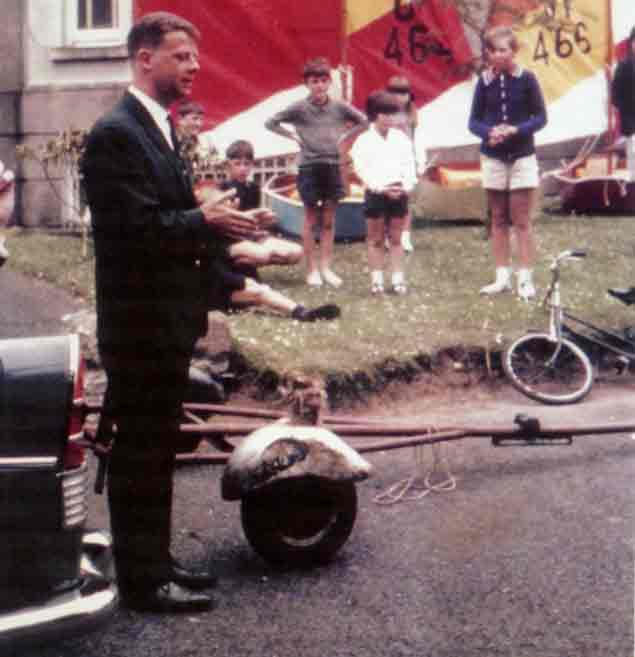 Olympic sailor Johnny Hooper speaking at the Blessing of the Boats as a new batch of home-built Optimists awaits transfer to the National’s limited space.
Olympic sailor Johnny Hooper speaking at the Blessing of the Boats as a new batch of home-built Optimists awaits transfer to the National’s limited space.
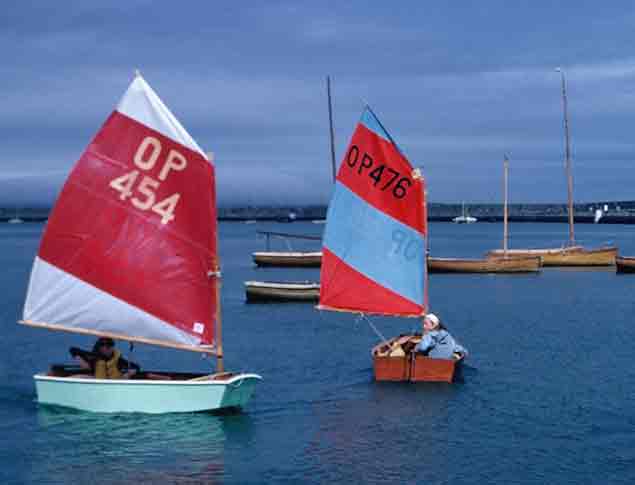 Dun Laoghaire was a different place in those days, with Water Wags and Mermaids expected to lie to mooring. Vivienne Lavery and Ann Kirwan testing their skills with the new Optimists – Ann’s boat (476) was one of the few professionally-built in the first batch of Optimists, she was created by the legendary Skee Gray
Dun Laoghaire was a different place in those days, with Water Wags and Mermaids expected to lie to mooring. Vivienne Lavery and Ann Kirwan testing their skills with the new Optimists – Ann’s boat (476) was one of the few professionally-built in the first batch of Optimists, she was created by the legendary Skee Gray
But though most young sailors in theory had his or her own boat, before anything approaching full fleet numbers was approached they’d a habit of letting anyone sail some boat or other in the early stages, so much so that although Ann Kirwan was part of it from a very early stage, she admits that even she can’t claim total accuracy when identifying the helm of a known boat.
 Going abroad......the new Dun Laoghaire Optimists make their debut at Bray Regatta: Paul, Adam and Lucy Winkelmann with Paddy Kirwan putting in his renowned act as a South American Air Marshall at Bray Sailing Club.
Going abroad......the new Dun Laoghaire Optimists make their debut at Bray Regatta: Paul, Adam and Lucy Winkelmann with Paddy Kirwan putting in his renowned act as a South American Air Marshall at Bray Sailing Club.
This habit of inter-changing sailors became even more marked in that first year when the early class discovered that the most useful base for their day-time sailing was the little-used Irish Lights service barge moored in the western part of the harbour. Over there, NYC Optimist sailors found much clearer sailing water, and they were well away from the comings and goings of the two cross-channel ferries off their home club, not to mention excessive parental control. In effect, the barge became their day-time base, and they ate their packed lunches aboard it while deciding who would take which boat for the first stage of the afternoon’s sailing. Fifty years down the line, we might well wonder if the Commissioners of Irish Lights are aware of the key role their humble barge played in launching Ireland’s Junior Training Programme.....
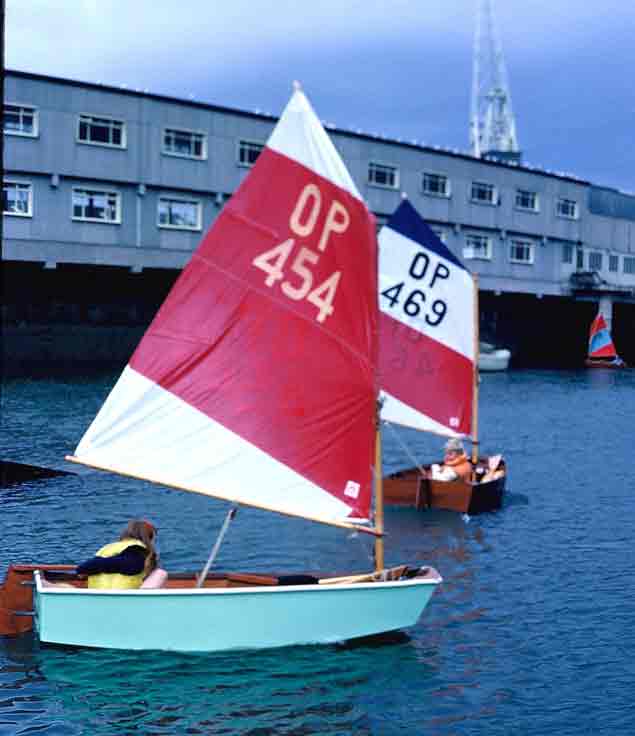 Vivienne Lavery and David Ryan getting away from the slip.
Vivienne Lavery and David Ryan getting away from the slip.
Once launched in its viable form in 1967, there was no stopping it, and the names which have emerged just from the National’s junior programme alone (for virtually all clubs now have one) take us over an extraordinary range, and up to the heights of Olympic participation, the winning of major world dinghy championships and associations with the America’s Cup.
It’s Johnny Smullen who provides the latter. The California-based Johnny Smullen in San Diego is now of world stature in anything to do with yacht and boat-building or indeed in marine construction generally, and his talent has been recognized at the highest level as he has worked on major projects for the very demanding Dennis Conner, aka Mr America’s Cup.
Johnny will have inherited his feeling for classics from his father Cass, a great sailor who was such an enthusiast for the Dublin Bay 21s in their original rather spectacular gaff-rigged form that when the class contemplated changing to a more easily-handled and convenient Bermudan rig in 1963, Cass claimed that he could easily rig a gaff-rigged DB 21 in 15 minutes flat. And that included setting the jackyard topsail to perfection. So he brought a DB 21 close into the clubhouse (as you could in those days), and in front of a drink-sipping crowd of observers on the verandah, he did the job within 15 minutes. But they still went ahead and converted to Bermudan rig.
Son Johnny meanwhile was enlisted in the NYC Junior Programme as soon as he reached he lower age limit, and when the 40th Anniversary was being celebrated back in 2007, he sent on his memoirs which well capture the flavour of it all:
San Diego, 17th May 2007
The way I saw it.
I am eight years old and my parents are wondering what to do with me for the summer, it went something like this: “Get him out from under our feet”. I was equally happy to stay at home and play in the back garden, invent stuff and dream up ways to frighten my sisters. Chasing them with worms was a good one.
I was enrolled in the adventure of my life.
At first I was lead to believe it was going to be a fun thing with the opportunity to meet new people and friends, maybe making me more sociable as I was quiet child in a world of my own. I bought into this and showed up for the first day. It was great, lots of people all different shapes and sizes, so there we were all sitting around playing with stuff and one-upping on how my father is better than yours, especially at snooker. The chatter fell silent when along came this very tall white-haired lady with an incredibly loud voice. It was at this point I became suspicious as I had just watched Paths of Glory and A Bridge Too Far, I had seen how the enemy rounded up people and put them in trucks and brought to places, unfriendly places.....
We arrived at Sandycove harbour where we were lined up on the pier. I though this was it, we were then forced to line up at the steps and walk down into the freezing water fully clothed and flail around, there were guards (instructors we were led to believe) everywhere, and just to make sure the torture was effective they made us hold our heads under water for 30 minutes, well 30 seconds, but it felt like minutes. Then we were all forced to walk back to the NYC where our fate was to be determined. Freezing and scared, I was cursing my family and wondering what I had done to them.
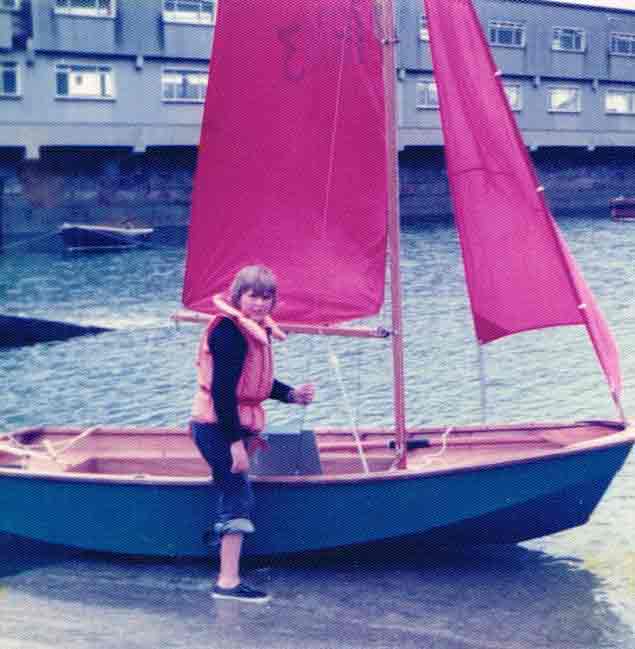 He survived.....eventually Johnny Smullen became a keen Mirror dinghy sailor, but he was pessimistic enough to call his boat Splinter
He survived.....eventually Johnny Smullen became a keen Mirror dinghy sailor, but he was pessimistic enough to call his boat Splinter
We arrived back at Camp NYC and were lined up and made to wear large cumbersome protective coats, some were yellow, purple, some orange, I guessed they were labelling us, something to do with our religion. Some of these jackets had large protective collars probably to help protect us from the beatings to come, I thought. Our names were branded onto the “Life Jackets” as I started to call them, knowing they would play a key role in our protection.
We were divided into groups and lead away by the guards into this large damp room with arches and a dank smell of cotton, hemp and mould. This was where we were to remain for all the rainy days to be brain-washed, they started by teaching us knots. I was convinced this was going to be how to tie the very knot that would be the doom of us, I compared it to carrying the cross of Calvary. I decided then to be really bad at it in the hopes that one of my knots would slip open and I could dash to my freedom. We also had to jump up, and hand-over-hand along the light blue steel beam that ran across the dark room, this was to make our arms really strong, they had a plan for strong arms – I will tell you about that a little later.
Food consisted of a march up to Wimpeys for a spice burger and chips all drowned in vinegar to disguise the taste, if there was good behaviour we got to go to the Miami Café. The day was long (except Thursdays when we had to get out early) and after a week in Boot Camp we were all tired and weary. What had I done to my family to deserve this?
The second week came along and we were introduced to the ships, rather large wooden craft resembling a landing craft with the flat bow (I was always looking for the hinges). This is where the strong arms came into. We were grouped into six per team, and the guards waited until low tide when we had to carry the ship down a rickety wooden slip (there’s a reason for calling it a slip). Upon its surface there were large wooden rollers but we were forbidden to use those rollers, and to make sure they filed a fat spot on the rollers, deeming them useless. We picked up the incredible heavy boat, all six of us, one on each corner holding a knee, and two in the middle by the oar locks. Later I was to learn the place to be was up at the bow (by the door), it was lightest. I was adapting to this cruel camp. As we descended down to the icy water again fully clothed, we came across a bright green pungent slime. I had what I thought were special sailing shoes, but as soon as I touched the slime I was down. Down hard. The guards started yelling, I knew I had to get up quickly....remember Calvary!....We reached the bottom and stopped, the guards yelled again and made us wade right into the icy deep, still fully clothed. With the landing craft now floating, we had to master manoeuvring, the craft were lined up alongside the slippy slip, that’s the reason they call it a..................
I stepped on the gunwhale. Now at this point I did not understand the physics like I do today, and when you apply a load to any point of the gunwhale of a flat-bottomed craft two things will happen (once only). The opposing gunwhale will come up as you travel down, and because I am as tall as the craft is wide, somewhere in the middle he two surfaces will meet, your face and the opposing gunwhale. After the initial shock, the second shock comes from the icy cold water. Then I found out what the large collar was for as the guards hauled me out of the abyss semi-conscious. Once inside the craft, we were grouped into two and handed oars. Let the games begin.....
After a week of rowing and shipping oars and coming alongside we were all adapting well to boating, there’s nothing to it. Just as we are enjoying ourselves, we are reminded that this is a work camp with launch and retrieval exercise twice a day. The launch and retrieval is carefully timed at 6 and 12 hours intervals to make sure it was low tide and we’d the longest slimiest walk up the rickety slips, observed closely by the guards from the window of the snooker room glaring down at us. Boating is turning out to be challenging but fun, and the new friends are all pitching together to eventually plan an assault on the guards to free ourselves.
The third week came along and there were large wooden poles with white canvas and a stick with notches cut out of it, why on earth did they have to make it harder? It was perfectly simple with the clean decks and oars and oar locks, now the boats are so heavy with this rig up, my bow lifting position is not that smart as we carry down the slip with the sail pressed hard against my face. After countless days of theory brainwashing in the damp room, we have to pass a few tests to prove worthy to sail, if called upon, out to the US Aircraft Carrier John F Kennedy anchored out in Dublin Bay. The first test was to take the stick with the notches and stretch out the canvas and hook onto a rope loop, without falling over this was harder than carrying the feckin’ boat, the second was to line up two pins while hanging over the transom full of chips and spice burgers. If it had hair....
Most of us mastered that task after a few tries, and it wasn’t long before we were sailing out to the sterns of the ferry Hibernia or Cambria, whichever was in port at the time. This went on for a few weeks and as we settled into the routine it got easier as we went on.
During the time in the damp boathouse, usually when it was blowing dogs off chains outside and while I was trying to get the batteries out of the loudhailer, I noticed a beautiful varnished clinker planked boat, it was almost new, and a very wise man was looking after it. This Man was tough as the rivets holding it together and knew everything about the seas. I knew if I paid attention he would help get me through the summer, he did and he is almost responsible for what I do today. Thank you Jack!
The discipline of Boot Camp had turned us into great sailors, great card players, snooker players....it wasn’t until the third stage we found flagons. But not on the night of May 17th 1975, I was at home doing my homework that night....
Ah.....the memories, I hope I have stirred a few, it was the most wonderful time of my life and I wish I was there to get drunk with all of you and play cards till the wee hours, but meanwhile thanks
To Carmel, thank you very much; I always have my lifejacket.
To Jack Brennan, I am always thinking of you up there, and thanks for teaching me how to tie my shoelaces.
To all the instructors Paul, Ann, Jimmy, I never believed the story of the rabbit and the tree, but thanks anyway
And to all my dear family and friends
Lots of love, Johnny Smullen
PS It was me that stuck the coke bottle in the cannon at the front of the club....
 Johnny Smullen and Dennis Conner inspect the hull of the 1925-built Cotton Blossom
Johnny Smullen and Dennis Conner inspect the hull of the 1925-built Cotton Blossom
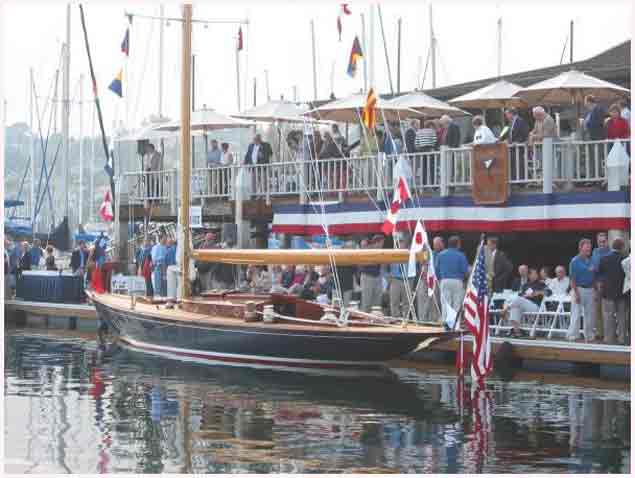 Cotton Blossom II after restoration by Johnny Smullen
Cotton Blossom II after restoration by Johnny Smullen
Inspired by Jack Brennan and other master craftsmen, Johnny has gone on to become a shipwright of such skill from his base in San Diego, California, that he in turn inspires others, one of his most famous projects being the complete restoration of the 49ft Q Class sloop Cotton Blossom II of 1925 vintage.
When a complete restoration is contemplated, Johnny doesn’t mess about. The word is that when he and Dennis turned up to finalise the deal on Cotton Blossom and bring her back to San Diego, they found the previous owners sorry enough to see her go, and rather proud of the style in which they’d maintained her. But after they’d gone to sort the details with the new owner, they went to take a last look at the boat. It’s said they found that Johnny had already delivered his opinion on the existing rig by cutting the shrouds and stays at the deck with bolt-croppers, and cutting the old mast off at deck level with a chainsaw.
Maybe that’s an apocryphal Johnny Smullen from taking delivery of another boat. Yet when you see Cotton Blossom in her restored form, it’s clear what Johnny says should indeed be Holy Writ. This is a project of world standard. But what’s even more remarkable is that despite everything the Sailing Boot Camp at the NYC might have inflicted on him all those year ago, Johnny’s love of boats and sailing is such that he has his own personal sweet classic, the lovely 36ft International One Design Altair. She’s sailed as often as possible, and though he can’t make it back to Dun Laoghaire next month for the Golden Jubilee as there’s very major project under way, Altair will be racing with the San Diego classics under the National Yacht Club burgee.
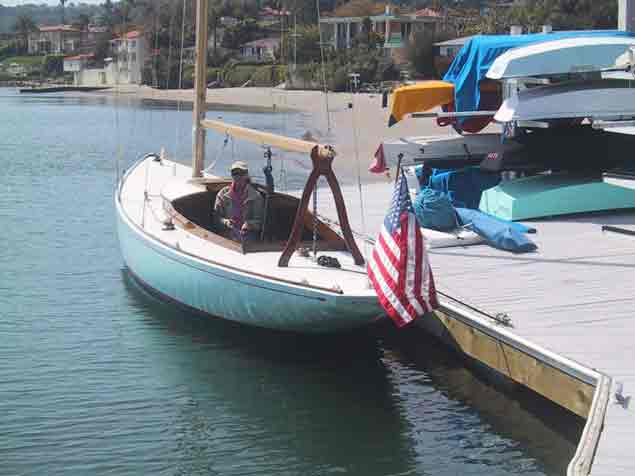 Johnny Smullen’s own pet boat Altair reveals his abiding love of sailing.
Johnny Smullen’s own pet boat Altair reveals his abiding love of sailing.
John Lavery’s father Arthur was another of those pioneering Optimist dads back in the late 1960s, and John and his sister Vivienne were both in that first batch of trainee sailors. He ended up winning championships in more classes then you could quickly count, but the peak of it all came in September 1995 when he and David O’Brien of this parish won the Fireball Worlds in Dublin Bay.
In fact, the graduates from 50 years of a junior training programme at the National YC can be found in successful positions in many boat classes in many places, but it is the club’s outgoing attitude to those who wish to learn to sail which deservedly provided its most outstanding success. A long time ago a Mrs MacAleavey, a widow with no sailing connections, was looking for a club which would make her increasingly boat-mad daughter Cathy – who had recently bought a clapped-out 420 – feel encouraged in any way to learn to sail. Despite the fact that it was still in process of recovering from a fire in the clubhouse, the NYC showed itself the most welcoming along the Dun Laoghaire waterfront, so much so that Mrs McAleavey felt sufficiently encouraged to buy her daughter a new 420, and that in turn led on eventually to Cathy representing Ireland in the women’s 470 in the 1988 Olympics.
The three children she had with husband Con Murphy went on to get their introduction to sailing through the National YC’s junior programme, and daughter Annalise emerged with the talent and the burning ambition which resulted in a heart-breaking fourth at the 2012 Olympics in the Women’s Laser Radial when a medal had seemid almost certainly within her grasp. But memories of that were entirely laid to rest with the Silver Medal in the 2016 Olympics Rio after a difficult final race in which the lone sailor seemed to stay as cool as you please, while the nation at home watched with bated breath.
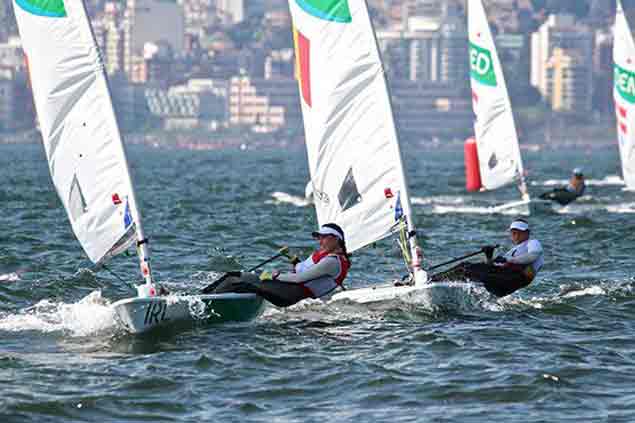 The medal-winning moment as Annalise Murphy crosses the finish line in Rio to win Silver.
The medal-winning moment as Annalise Murphy crosses the finish line in Rio to win Silver.
That it was ultimately a very personal achievement is something respected by her club, and they claim to have done nothing more than provide the first steps on the pathway, and a general spirit of encouragement. But nevertheless the success is all of a piece with the Golden Jubilee which will be celebrated on May 20th, and Carmel Winkelmann continues in her mission of providing a background of training for young sailors of all types, whether they aim only to be a competitive club sailor, or whether they aim for the ultimate heights.
Thus one of her projects in recent years was to find real support for young Finn Lynch, who had reached that difficult stage of being a top junior sailor, yet still had to find his feet as an adult. Thanks to support raised by Carmel, he became Ireland’s representative in the Men’s Lasers at Rio despite going through the final stages of the selection with a training injury recovery problem which may have had an adverse effect on his performance in as the youngest sailor in Rio, aged just 20.
Whether or not he would have been better off not being in Rio at all is neither here nor there. When you’re 20, four years can seem an appallingly long time. The Tokyo Olympics in 2020 must have seeemed aeons away for a young sailor who had shown many flashes of real talent. It was better for him to be in Rio while learning a lot, rather than kicking his heels in frustration in some dead end. And when he needed material help to see through the campaign, it was Carmel Winkelmann who was there to make to ensure that support was available. That will be something else for celebration on May 20th.
 Carmel Winkelmann and Finn Lynch at the National Yacht Club, June 2016. Photo W M Nixon
Carmel Winkelmann and Finn Lynch at the National Yacht Club, June 2016. Photo W M Nixon
Fabulous Final Fling for Frostbiters in Dun Laoghaire
The Dun Laoghaire Frostbite fleet had enjoyed a sunny Saturday in advance of the last day of racing in the 2016/17 Series and early on the Sunday morning there was a further bonus when the Race Management Team advised all participants by Facebook that with the weather in hand we would be racing outside the harbour. The forecast was for 10 – 15 knots from an ENE direction but on arrival at the club there didn’t seem to be quite that much. The sail out to the race area under blue skies and warm sunshine was very pleasant in the sheltered waters of the harbour but outside with a wind against tide scenario there was more of a chop. An early check of the course suggested that going right might be the better option with tide rather than wind being the more critical parameter for the best route to the weather mark.
A General Recall for the Lasers gave an indication of the challenge to prevent the tide sweeping the starters over the line. The Fireballs had a clean start with Neil Colin & Margaret Casey (14775) electing to go right immediately on the five-lap triangular course. Frank Miller & Cormac Bradley (14713) and Alistair Court & Gordon Syme (14706) also went right but not immediately. The balance of the fleet – Noel Butler & Stephen Oram (15061), Louis Smyth & Glenn Fisher (15007), Cariosa Power & Marie Barry (14864), the “pink ladies” Louise McKenna & Hermine O’Keeffe (14691) and the Keegans, Peter & Michael (14676) all put in an element of left-hand side before they came back right.
The consequence of this early division is that Miller, Colin and Court were in the fight to get round the weather mark first. Miller ultimately won out for that privilege but both Colin and Court were close on his transom and despite an early sense of having gone the wrong way, Butler was just behind this lead group of three. Down the second leg of the triangle Court and Colin pushed Miller for the lead and while there were overlaps at the gybe mark, Miller still had the lead. On the second reach, Miller was being pushed by Butler and Court and these three found themselves much more to weather than Colin who discreetly sailed a quieter leg to join the other three in a seamless rounding – almost but not quite – transom to bow of the leeward mark.
Up the second beat there was much more time spent on the right hand side of the course and at the second weather mark Miller conceded the lead to Butler, by a small margin but still had to watch Court and Colin who rounded close behind him. The next two legs were a game of cat and mouse between these three while Butler stretched his lead.
There was fun and games at the second leeward mark as Miller got inside a Laser Vago at the three boat-length mark which initially seemed to be enough to squeeze Colin out for water at the mark but a “coming together” between Colin, the Laser Vago and Miller saw some elevated voices and led to Miller taking turns in response to a suggestion that he go home. Relegated to the back of the fleet, it afforded this correspondent to see what was happening with the rest of the fleet. The “pink ladies” were behind the leading three, Butler, Court and Colin, but sailed a great third beat to get into second place. Smyth and Power were keeping each other company around the course and by the third weather mark the order was Butler, McKenna, Court, Colin, Smyth, Power, Miller and Keegan. Miller got two places back over the next two legs to get back in the hunt for a podium place. Butler, meanwhile, was stretching his lead while those behind him were expending energy watching those around them.
McKenna latter half of the race did not go to plan as she dropped back from her lofty second place as Colin, Court and ultimately Miller passed her out. However, with the weather that was in it, trapezing conditions and a tricky tide nobody, other than Butler, could be sure of their finishing position.
|
Frostbites 2016/17; Race 9 Series 2 26th March 2017 |
||
|
1 |
Noel Butler & Stephen Oram |
15061 |
|
2 |
Alistair Court & Gordon Syme |
14706 |
|
3 |
Neil Colin & Margaret Casey |
14775 |
|
4 |
Frank Miller & Cormac Bradley |
14713 |
|
5 |
Cariosa Power & Marie Barry |
14854 |
|
Frostbites 2016/17: Series 2; Overall |
||||
|
1 |
Noel Butler & Stephen Oram |
15061 |
NYC |
11 |
|
2 |
Louise McKenna & Hermine O’Keefe |
14691 |
RStGYC |
24 |
|
3 |
Frank Miller & Cormac Bradley |
14713 |
DMYC |
26 |
|
Frostbites 2016/17: Overall; 19 Races, 5 Discards |
||||
|
1 |
Noel Butler & Stephen Oram |
15061 |
NYC |
16 |
|
2 |
Conor & James Clancy |
14806 |
RStGYC |
39 |
|
3 |
Neil Colin & Margaret Casey |
14775 |
DMYC |
45 |
Special mention must be made of one particular participant in Sunday’s race! Days after celebrating a very significant birthday, his 80th, Louis Smyth was on the water racing with Glenn Fisher. He is an astounding testament to what is possible with a determination that says age is just a number. He is an exceptional character who has served two terms as Fireball International Class Commodore, sailed more international events around the globe than possibly any other active Fireballer, has been an enormous source of logistical and technical support to the Irish fleet and is the epitomy of the adage that sailing is a sport for all ages. Many, many congratulations Louis on a significant milestone!!
At the Frostbite prize-giving there were prizes for the second half of the series and the overall series. This was the 42nd hosting of the Frostbites which continue to be an enormously popular event during the “off-season”. The Commodore of DMYC welcomed everyone to the event and offered his thanks on behalf of the club for the significant team of volunteers who make the Fristbites happen every year.
At the conclusion of the prize-giving, having previously thanked his support team, Frostbites organiser Olivier Proveur announced that due to increasing time commitments he would be standing down from the role, after twenty-two years of service to the Frostbite community. An impromptu vote of thanks by Monica Shaeffer (Wayfarer) to Olivier was concluded with sustained applause and a rousing “three cheers” for the man who has given so much of his time for everyone else’s enjoyment during the winters of the past 22 years.
Merci beaucoup Olivier!
On Sunday a Fireball launched quietly in the Coal Harbour Dun Laoghaire for the last DMYC race in a very successful series writes Frank Miller. "Nothing to see here" probably thought the majority of those walking the pier as they watched Louis Smyth and crew Glen Fischer sail out to the harbour mouth in light wind and beautiful conditions.
In fact the event was remarkable as just a couple of days before Louis celebrated his 80th birthday.
To sail any boat as octogenarian is an achievement but to sail a fast demanding racing dinghy while still remaining competitive at that age is a triumph.
Hats off to Louis Smyth and many more years of happy sailing.
Lively Fireball Frostbite Race at Dun Laoghaire Harbour
Today saw very lively conditions for the third last weekend of the DMYC frostbites series at Dun Laoghaire writes Frank Miller. The forecast was suggesting up to force five but in fact the wind Gods delivered a bit more. By the start of the race, the wind was a very solid 16–knots gusting 22. A diminished bunch of sailors did a few test laps of the trapezoid in a Norwesterly breeze before racing got underway.
First Fireball out was Frank Miller with guest star crew Ismail Inan in Dublin on a flying visit, wrapped up a mix and match of spare sailing gear. The pair sped around the course in an attempt to settle back into some kind of groove since the last time the pair sailed together was in the Europeans in Shetland. Things were going well enough until the UJ on the tiller extension broke and the pair sailed slowly and painfully back to the DMYC to pick up a spare. Meanwhile Noel Butler/Owen Laverty appeared on the horizon followed by the Keegans, the Clancys and the "pink ladies" Louise McKenna and Hermine O'Keefe.
By the time racing got underway your correspondent was rooting in his car boot for his spare tiller extension and by the time he returned to the fray racing was underway.
Thus Miller/Inan joined in at the back, one lap in, trying not to interfere with the legitimate starters. From this position we can report that Butler/Laverty sailed a cool solid race keeping things under control and the boat flat, no mean achivement in a race where the majority of all fleets had multiple capsizes. This was brought on by gusts of 36 knots about 40 minutes into the race, keeping the rescue ribs on their toes. Butler's laps of honor saw the Clancys nearest, followed by the Keegans, and Miller/Inan. Thus it ended, by the finish the race committee deemed conditions hairy enough to send everyone home, tired but happy.
Though those returning to the DMYC had the additional pleasures of Hells Gates to navigate in alternate massive gusts and complete lulls. The Keegans won the mug for their troubles.
Racing resumes next Sunday, and then one Sunday sees the conclusion of the series




























